Introduction
Overall Design
{{section_header}}{{section.name}}{{/section_header}}
The {{product.name}} is not the most pulchritudinous television we've seen recently. The whole TV is too bulky for us, with the bezel being a bit larger than average, CCFL backlighting forcing a thick profile, and a big block of plastic for a stand.
There are a few nice touches however. The bezel has a fake, black-stained wood texture, which is a nice deviation from the obvious shiny black plastic. Also, the VIZIO insignia in the center, bottom part of the bezel lights right up when you turn the power on. You can turn this option off if it's not your thing.
Front
{{section_header}}{{section.name}}{{/section_header}}

Back
{{section_header}}{{section.name}}{{/section_header}}

Sides
{{section_header}}{{section.name}}{{/section_header}}

Stand/Mount
{{section_header}}{{section.name}}{{/section_header}}
The stand is a wedge-shaped piece of plastic that looks like it will sturdily hold the large display. It is unfortunately static, so turning the entire TV to get to the ports in the back will be a chore with this big guy.

Remote Control
{{section_header}}{{section.name}}{{/section_header}}
The remote for the {{product.name}} controls basic television functionality and cannot be programmed for other devices. For what it is intended to do, it works just fine.
The buttons on this remote have excellent key travel. Each button provides a satisfying haptic response and bounces your fingers right back for more pressing. We actually had fun pushing these buttons, as much fun as you could have playing with a remote really. We did notice that, while the buttons felt good, they were really loud. Clicking through the menus was a little annoying and would certainly be distracting when watching your favorite movie.

In the Box
{{section_header}}{{section.name}}{{/section_header}}
In the box there were two instruction manuals, a remote with batteries, a cleaning cloth, a safety tether, a detachable power cord and written warranties.
Black Level
{{section_header}}{{section.name}}{{/section_header}}
The {{product.name}} will not be able to display blacks as richly dark as a plasma screen or the unusually dark Sony LCD in the comparison below. A reading of 0.36 cd/m2 falls in the average range for and LCD screen. More on how we test black level.
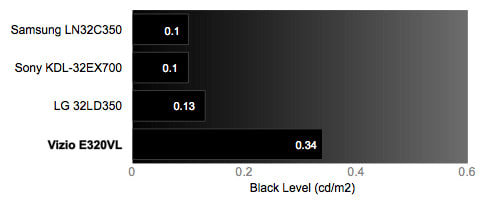
Peak Brightness
{{section_header}}{{section.name}}{{/section_header}}
This VIZIO makes up for its average black level with a substantially high peak brightness. There will be no worry of ambient lights competing with the luminance of the {{product.model}}, making it ideal for anywhere you plan to watch it. More on how we test peak brightness.
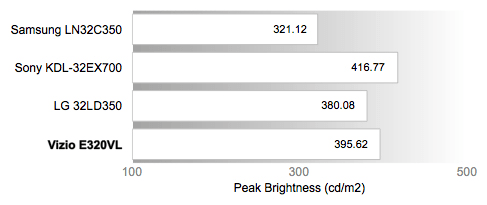
Contrast
{{section_header}}{{section.name}}{{/section_header}}
Divide peak brightness by deepest black and you end up with contrast ratio. A ratio equal to or greater than 1000:1 is commendable and the {{product.name}} exceeds this value, mostly due to its sparkling peak brightness. More on how we test contrast.

Tunnel Contrast
{{section_header}}{{section.name}}{{/section_header}}
In our Tunnel Contrast test, we see if changing the area of the screen displaying black will affect the brightness of the screen. Though there are some hills and valleys on this chart, the changes are not significant enough to be noticed. The black level stays very consistent with changes in areas of black. More on how we test tunnel contrast.
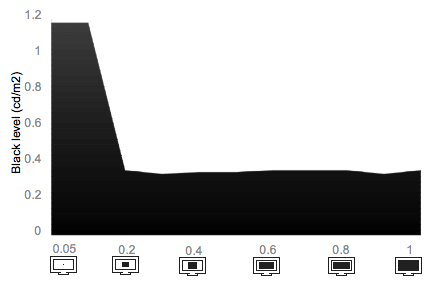
White Falloff
{{section_header}}{{section.name}}{{/section_header}}
The White Falloff test is like the Tunnel Contrast test, but with areas of pure white. Ideally, the area of white on the screen should not affect the brightness of that white value. Under scrutiny, the {{product.name}} didn't even bat an eye, displaying a consistent luminance regardless of how much white was on the screen. The steady horizontal line in the chart below is all the evidence we need. More on how we test white falloff.
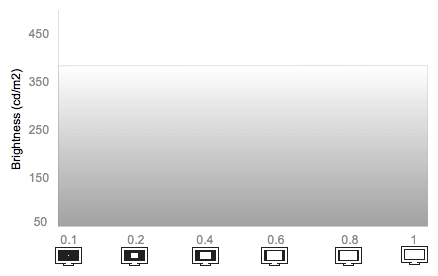
Uniformity
Greyscale Gamma
{{section_header}}{{section.name}}{{/section_header}}
Ideally, the graph below should be uneventful. We are looking for a smooth, straight line with a slope between 2.1 and 2.2. Such a line would represent a television transitioning incrementally from one grey value to another along the entire spectrum from black to white.
The greyscale gamma graph for the {{product.name}} shows an average performance. The slope of the line, 2.6, isn't quite within the quintessential range and the line isn't exactly smooth, meaning the {{product.model}} cannot properly display all the values of grey on a 0 to 255 scale from black to white.
The dark end of the spectrum is a little crushed, demonstrated by the shallow, curved slope at the begging of the line. Crushed blacks mean that the incoming signal may be asking for a dark grey, but the {{product.model}} is outputting a much darker value or 100% black, inhibiting differentiation in darker values.
The {{product.model}} is outputting black when the signal asks for dark grey. If the signal asks for a darker value, how much more black can the screen get? The answer, famously, is none. None more black. More on how we test greyscale gamma.
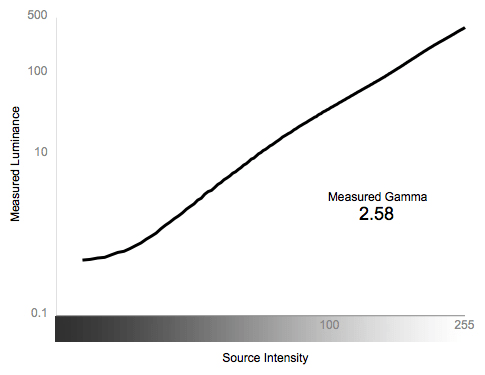
Color Temperature
{{section_header}}{{section.name}}{{/section_header}}
Mostly consistent, the color temperature spikes into the cool towards the darker end of the brightness spectrum. You may see a blue tint to darker images like shadows or dark clothing. More on how we test color temperature.

RGB Curves
{{section_header}}{{section.name}}{{/section_header}}
These curves are close to ideal with a few flaws. There are some bumps in what should be completely smooth lines. Bumps show that the {{product.name}} is giving the wrong color value for the given signal. This means that the {{product.model}} displays fewer than the standard 256 values of color from darkest to brightest.
The early part of the graph, at the dark end of the spectrum, is too shallow. Like the Greyscale Gamma test earlier in this review, the dark end of the spectrum is crushed, and the {{product.name}} loses the ability to differentiate one value from another given darker pictures.
All things considered, the {{product.name}} scores well for an entry-level model. More on how we test RGB curves.

The bars of color below are visual representations of the RGB curves we just discussed. Notice the dark end of the spectrum encroaching far past what you see in the ideal response, which coincides with the early part of the graph above being too shallow.
Motion Performance
{{section_header}}{{section.name}}{{/section_header}}
Moving objects glided smoothly across the screen. We didn't notice any of the normal juddering or much detail loss evident in entry-level televisions, but there were some serious artifacts. Artifacts are creations of the television that arise when the TV cannot produce exactly what is in the original signal.
We saw some major stair-stepping on the edges of moving objects, the most obvious infractions occurring with high contrast, high frequency patterns. Jagged edges, or pixel stair-stepping, occur when a television's processor cannot move all parts of an object at the same time.
Other than jagged edges, the {{product.name}} moved objects very well, especially considering its entry-level status. More on how we test motion performance.
3:2 Pulldown & 24fps
{{section_header}}{{section.name}}{{/section_header}}
Video signals originally broadcast at 30fps (30Hz) and today's refresh rates are factors of this standard, like 60Hz or 120Hz. Unfortunately, films have always been shot at 24fps, and converting 24fps to 30fps is difficult, notoriously resulting in flickering because the signal strobes at a different rate than the display screen.
Televisions today try to accommodate 24fps with adjustable film modes. These film modes use a complicated process called 3:2 pulldown, which involves creating half frames every fourth frame in order to convert 24fps to 30fps, or by changing the television's native refresh rate to a factor of 24fps.
Film Mode on the {{product.name}} was only a slight improvement on 24fps content, eliminating some flickering in moving high frequency patterns. However, there was a distracting amount of judder at 24fps, most conspicuous with actual content, that was not apparent in other frame rates. The picture wobbled as it panned and it would be hard to imagine anyone enjoying such a shaky picture. More on how we test 3:2 pulldown and 24fps.
Resolution Scaling
{{section_header}}{{section.name}}{{/section_header}}
Between resolutions, the {{product.name}} did well, displaying little overscan, while showing minor interference on high frequency patterns. More on how we test resolution scaling.
480p
Converting from HD resolutions to standard resolution also changes the aspect ratio from 16:9 (widescreen) to 3:4 (standard) and some overscan will occur as a result. We saw an all-around 8% overscan, meaning 8% of the picture was off screen somewhere, but more unsettling was that the picture was off-center. We messed with the picture positioning and could not get it to be right in the center, but it should not be a huge problem. Otherwise, 480p was not a problem for the {{product.model}}, as it handled all of our test patterns smoothly.
720p
720p showed minor difficulties with legibility of small fonts and the highest frequency pattern we had, but mostly it was superb. There was no overscan at this resolution.
1080p
In its native 1080p, the {{product.name}} showed no overscan and handled our tests confidently. The only misstep was a slight artifact of yellow-green tint to one of the moiré patterns, but intricate detail was not a problem.
Formats
{{section_header}}{{section.name}}{{/section_header}}
The {{product.name}} displays a native 1080p picture and can handle all NTSC standard video formats.
Viewing Angle
{{section_header}}{{section.name}}{{/section_header}}
For an LCD screen, the {{product.name}} had a decent viewing angle. Still, 35º off center for a total of 70º of viewing isn't great, and if viewing angle is a chief concern, you should look at a few plasma models instead.

Reflectance
{{section_header}}{{section.name}}{{/section_header}}
A tight, little, rainbow, dispersion pattern was reflected when we shined bright LED lights directly at the screen of the {{product.name}}, while playing a movie. This shows us that the {{product.model}} has apparatuses in place to diffuse bright lights. However, this light pattern was significantly larger on a black screen and adding angle to the lights did not improve the situation. The lights were not very annoying, but certainly noticeable, which may affect your enjoyment if there are bright lights in the same room as this TV.
Video Processing
{{section_header}}{{section.name}}{{/section_header}}
There are a few video processing modes on the {{product.name}}, but none of them seemed to make much of a difference, and the slight differences were not necessarily improvements.
Calibration
{{section_header}}{{section.name}}{{/section_header}}
We didn't change too much on the {{product.name}} to get the optimal picture output. In the table below you can see the settings we used.

All of our calibration is done in conjunction with the DisplayMate software.
](http://www.displaymate.com/)
Video Modes
{{section_header}}{{section.name}}{{/section_header}}
Experiment with the picture modes to see what you like, but know that they are all different than the ideal we reached using DisplayMate software.
Connectivity
{{section_header}}{{section.name}}{{/section_header}}
The ports are found on the back and the left side of the {{product.name}} in an extremely tight configuration. Though there is space for connections with two HDMI ports, a composite and component each, VGA with 1/8th inch audio, cable/antenna connection, and the analog in and out, they are packed so closely together that the wires extending out will form a thicket of cables. If you have an entourage of older devices, you may have to plan out the sequence of how you connect them all. There is one stray USB port on the side of the {{product.model}} ready for quick media playback.

Placement
{{section_header}}{{section.name}}{{/section_header}}
The ports are to the left of the display, on the side and the back. The ports on the back are a little out of the way because the stand does not pivot. Further, the analog connections on the back are well organized, but again they are tightly packed and you will have to plan the best way of getting all your devices connected. Once it’s all set up, you may be forced to unplug everything just to change one device.
Audio Quality
{{section_header}}{{section.name}}{{/section_header}}
The sound coming from the 10W speakers was a little canned without the TruSurround audio setting engaged. However, TruSurround did not provide anything like a surrounding sound experience, rather it seemed to enlarge the range of frequencies produced by the {{product.name}} thereby increasing the quality. TruSurround is a good feature, just poorly named. This is a large television and you should probably invest in some better speakers if you want to impress your friends.
Menu Interface
{{section_header}}{{section.name}}{{/section_header}}
The {{product.name}} comes with a dapper set of menus that are easy to navigate. They do affect the picture by squishing it slightly to the right when you click the menu button. We like this because the menus do not obscure your viewing entirely.

One peeve was that the advanced picture settings are located within picture settings and switching them on and off took some time. If you feel the need to adjust video processing modes for each type of content, you may get a little frustrated.

Instruction Manual
{{section_header}}{{section.name}}{{/section_header}}
The {{product.name}} comes with two glossy manuals: a Quick Start Guide to get you up and running, and a more extensive User Manual with all the details. The User Manual is an easy read with a straight forward table of contents. There is no index for quick reference, and no tabbed sections, but its not long enough for these deficits to hold you back.
We gave a few extra points in this section because you get two manuals, both with excellent photos, detailed with helpful call-outs that explain all of the connections. There is also a grid matrix that demonstrates the scenarios and screen size settings that will result in overscan.

A manual for so many TV models, they have to be further categorized by type.
Local Media Playback
{{section_header}}{{section.name}}{{/section_header}}
The USB port on the {{product.name}} is limited to photos and music, further limited to only JPEG and MP3 formats. Although, it wouldn't play the MP3 from our USB thumb drive. You can do all the standard slideshow manipulation: slide speed, add music (supposedly), photo ordering etc. What you cannot do is zoom in on any of the pictures. The resolution of the file dictates how large it will be on a 47-inch screen; usually very small.

All of that is fine and good, until you want to leave the USB media interface and go back to your regularly scheduled programming. The buttons Exit, Back, Menu and Last become inutile, though their names would seem to be exactly what you want. You have to press the Media button to get back to regular TV, which is a little confounding.
Given the poor interface, the lack of format flexibility, no video capability, and no zooming options, it is hard to imagine anyone using this feature at all. Well, maybe people will use it once, and then never again.
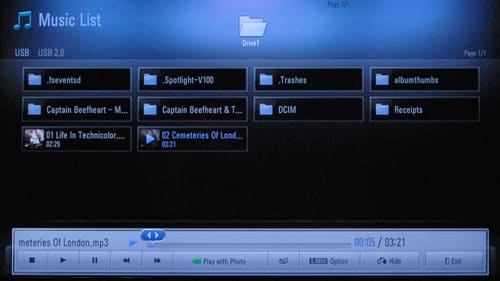
Power Consumption
{{section_header}}{{section.name}}{{/section_header}}
The screen on the {{product.name}} gets very bright, and you could save some money by decreasing the backlight from 100 to 52, where we recorded the cost below. At full brightness, this model will cost $37.69 for the year.
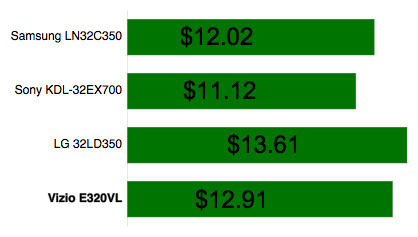
Value Comparison
{{section_header}}{{section.name}}{{/section_header}}
The {{product.name}} has a better contrast ratio, a steadier set of colors, a slightly wider viewing angle, more analog ports and is cheaper than the Panasonic TC-L42U30. An easy win for VIZIO.
Blacks & Whites
{{section_header}}{{section.name}}{{/section_header}}
The {{product.name}} beat this Panasonic on both ends of the luminance spectrum with a higher peak brightness and a deeper black level, therefore a better contrast ratio.

Color Accuracy
{{section_header}}{{section.name}}{{/section_header}}
The Panasonic had a more accurate set of colors according to the rec. 709 standard, but the {{product.name}} had much smoother RGB curves and a more even color temperature. You will get a much steadier set of colors with a much better range of value distinction on the VIZIO.
Motion
{{section_header}}{{section.name}}{{/section_header}}
These two sets had very similar motion processing scores, the VIZIO showing better smoothness and worse artifacting.
Viewing Effects
{{section_header}}{{section.name}}{{/section_header}}
With nearly identical viewing angles on these two TVs, the {{product.name}} barely squeaks ahead of the Panasonic.
Connectivity
{{section_header}}{{section.name}}{{/section_header}}
The Panasonic has one more HDMI port and can read SD/SDHC cards used for digital cameras, but it is lacking in analog connectivity. If you have older devices or a Wii, you will want the {{product.name}}.
Value Comparison
{{section_header}}{{section.name}}{{/section_header}}
The {{product.name}} cannot compete with this Sony's fantastic range of lights and darks, but this kind of performance will cost you $250 more. Other than that, these two sets might as well be twins from different kin.
Blacks & Whites
{{section_header}}{{section.name}}{{/section_header}}
This entry-level Sony has one of the best ranges of luminance for an LCD screen on the market, resulting in a contrast ratio of over 7000:1. We think the {{product.name}} will sit this one out.

Color Accuracy
{{section_header}}{{section.name}}{{/section_header}}
Color accuracy was about the same on these TVs, the most notable differences being a more even color temperature on the Sony and a more correct gamut of colors on the {{product.name}}. Given that the color temperature variances were limited to the dark end of the spectrum, we can say that the {{product.name}} is a better color producer.
Motion
{{section_header}}{{section.name}}{{/section_header}}
These two sets scored exactly the same on our motion tests, both having no problem with smoothness, but showing plenty of artifacts.
Viewing Effects
{{section_header}}{{section.name}}{{/section_header}}
The {{product.name}} has a wide viewing angle for an LCD, we know this in comparison to the Sony KDL-46BX420 which is about average.
Connectivity
{{section_header}}{{section.name}}{{/section_header}}
The port offerings on these televisions are essentially the same. There is one more analog audio input on the {{product.name}}, but more significantly, the UI for the USB media connection is much stronger on the Sony.
Value Comparison
{{section_header}}{{section.name}}{{/section_header}}
The E3D420VX is a features machine providing DLNA content, 3D imaging and a usable USB media system. It is definitely a step up the VIZIO ladder, with five fewer inches of screen, for about $100 more, but if you want to get on the streaming media and home 3D train, the E3D420VX is your ticket.
Features are not the only advantages for the money. You get a better contrast ratio, better motion performance due to video processing modes and more connections on the E3D420VX. The {{product.name}} has advantages in color accuracy and viewing angle. If price is your main concern, then the {{product.model}} is the choice, but this is one situation where the extra money will actually get you a better device.
Blacks & Whites
{{section_header}}{{section.name}}{{/section_header}}
The E3D420VX has a deeper black level and a higher peak brightness than the {{product.model}} by just enough to make the contrast ratio significantly larger.

Color Accuracy
{{section_header}}{{section.name}}{{/section_header}}
The E3D420VX had a perfect color temperature, in that it did not vary outside the perceptible limit at any given level of signal intensity. The {{product.model}} had a more accurate set of colors and slightly smoother RGB curves but the dark values were so crushed that you can see how much of the spectrum is too dark in the color strip comparisons.
Motion
{{section_header}}{{section.name}}{{/section_header}}
The E3D420VX has the same processor, but with the addition of video processing functions that helped best our motion tests. Without these processing functions, the {{product.name}} could not get rid of the jagged edge artifacts on moving objects. As a caveat, we usually advise turning off motion processing when watching film-based content because it can look strange; like something recorded on a home video camera. With these functions off, as we advise, these two perform about the same when handling motion.
Viewing Effects
{{section_header}}{{section.name}}{{/section_header}}
The viewing angle on the {{product.model}} was exceptional, and thus was worse on the average E3D420VX.
Connectivity
{{section_header}}{{section.name}}{{/section_header}}
The E3D420VX has one more HDMI port, Wi-Fi, Ethernet, and an actually useful USB port.
Other Comparisons
{{section_header}}{{section.name}}{{/section_header}}
The E3D420VX provides its owner with DLNA streaming content and 3D imaging, where the {{product.model}} does not. We don't care much for 3D, so you can consider that point moot, but streaming content is pretty cool and especially cheap on the E3D420VX.
Conclusion
There is nothing flashy about the {{product.name}} ($620 MSRP). Televisions today can have overwhelming lists of features and extras that you may not use, may not know how to use, or just do not want at all. We certainly understand not wanting to pay an extra $200-500 for 3D at home, but most larger televisions these days do not give you the option. The only bell/whistle on the {{product.model}} is the USB side port, but you don't have to worry about that because it doesn't work so well anyway.
The {{product.name}} provides consumers with a large, straight-forward television with decent all-around performance. You will get a strong motion performance and a solid contrast ration with this VIZIO. Viewing angle was especially wide on this VIZIO, and if you are looking for basic and functional, this is a quality you should definitely note.
There were some problems with the dark end of the spectrum for both color and black-and-whites. At darker luminances, the color temperature was noticeably cool, or blue. Also, all darker values were crushed together and impeded heavily on the brighter side of the spectrum. All of this will combine for significant loss of detail in darker scenes.
Though the {{product.model}} is definitely not high-end, you will get a large screen that will do what you need. If you feel anxious about all the new television technology these days, but you have a room that calls for a big screen, you will find a good buy with the {{product.name}}.
Model Series Comparison
{{section_header}}{{section.name}}{{/section_header}}
The {{product.name}} is an entry-level television providing a big screen and decent all-around performance for a reasonable price.
Photo Gallery
{{photo_gallery "Front Tour Image", "Back Tour Image", "Sides Tour Image", "Stand Photo", "Controls Photo", "Remote Control Photo", "Connectivity Tour Image 1", "Connectivity Tour Image 2", "Connectivity Extra Photo", "Menu Main Photo", "Menu 2 Photo", "Internet Features 1 Photo", "Internet Features 2 Photo", "Internet Features 3 Photo", "Local Media Playback 1 Photo", "Local Media Playback 2 Photo"}}
Ratings & Specs
{{manufacturer_specs_table}}
Meet the tester
Christian Sherden is a valued contributor to the Reviewed.com family of sites.
Checking our work.
Our team is here for one purpose: to help you buy the best stuff and love what you own. Our writers, editors, and lab technicians obsess over the products we cover to make sure you're confident and satisfied. Have a different opinion about something we recommend? Email us and we'll compare notes.
Shoot us an email
